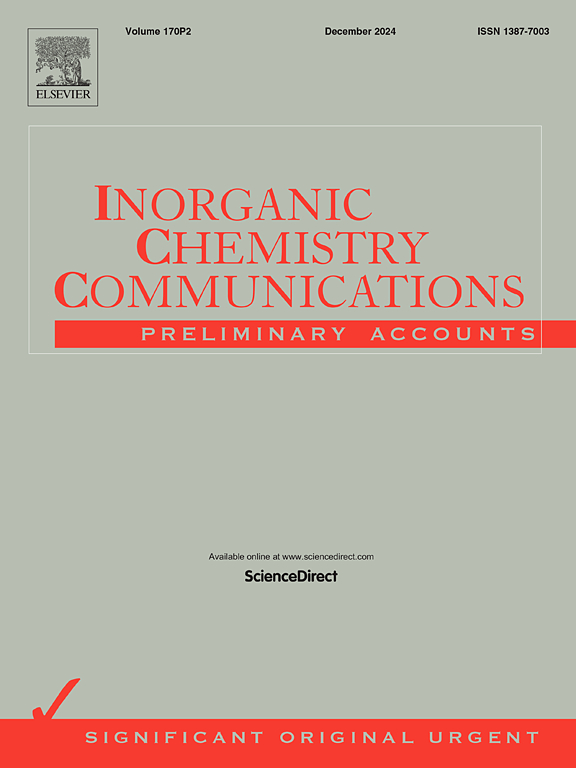Nickel(II) and copper(II) coordination complexes based on novel ligands generated in situ from the tetradentate 2,4-pentanedione bis(thiosemicarbazone) and the thiocyanate ion: Network topologies, and computational approaches
IF 4.4
3区 化学
Q1 CHEMISTRY, INORGANIC & NUCLEAR
引用次数: 0
Abstract
The synthesis of the [NiII(H2L3)]SCN 1 and [CuIIL4(SCN)]⋅2DMF 2 complexes was carried out using the proligand 1-thiocarbamoyl-3,5-dimethyl-5(thiosemicarbazido)-2-pyrazoline (H2L2); derivative from 2,4-pentanedione bis(thiosemicarbazone) (H3L1), the thiocyanate ion and the divalent metal ions of nickel and copper. Complex 1 was prepared by reaction of the cyclic ligand H2L2 with a solution containing the SCN−, Ni2+ and Cu2+ ions. Single crystal X-ray diffraction (SC-XRD) study revealed that this complex is a cationic mononuclear complex of NiII with a new generated ligand (H2L3)−, arising from the establishment of a bond between the nitrogen atom of the thiocyanate and the central carbon atom of the organic ligand (H3L1). The geometry around the nickel is square planar of MN2S2 mode, while the second thiocyanate played the role of counter-anion in the Ni(II) complex structure. With a solution containing only the thiocyanate and the cupric ions, the proligand H2L2 leads in two steps to the complex 2 which is based on an original heterocyclic ligand issue also from the reaction of thiocyanate ion with H3L1 ligand, but in different way. The crystallographic study revealed a new coordination sphere of square planar geometry where the new ligand (L4) is in tridentate mode (N2S) and a thiocyanate ion is linked in terminal mode by the nitrogen atom. In addition to XRD, the title complexes have been characterized using FTIR, UV–Vis, as well as Hirshfeld surface analysis and plausible mechanisms have been proposed to explain the in situ formation of the new ligands. Furthermore, the synthesized coordination complexes were studied by PASS, molecular docking, and in silico ADME assessments to evaluate the biological activity, molecular interactions, and pharmacokinetic properties. PASS Prediction identified enhanced antineoplastic activity in ligand–metal complexes, confirmed by molecular docking against Cyclin-dependent kinase 2 (CDK2) receptor for a xenograft cancer.
基于四齿2,4-戊二酮双(硫代氨基脲)和硫氰酸盐离子原位生成的新型配体的镍(II)和铜(II)配位配合物:网络拓扑结构和计算方法
[NiII(H2L3)] scn1和[CuIIL4(SCN)]⋅2dmf2配合物的合成采用前配体1-硫代氨基-3,5-二甲基-5(硫代氨基脲)-2-吡唑啉(H2L2);由2,4-戊二酮双(硫代氨基脲)(H3L1)、硫氰酸盐离子和镍、铜的二价金属离子衍生而来。采用环配体H2L2与含有SCN−、Ni2+和Cu2+离子的溶液反应制备了配合物1。单晶x射线衍射(SC-XRD)研究表明,该配合物是由硫氰酸盐的氮原子与有机配体(H3L1)的中心碳原子之间建立键而产生的NiII与新生成的配体(H2L3)−的阳离子单核配合物。镍周围的几何结构为MN2S2模式的方形平面,而第二硫氰酸盐在Ni(II)配合物结构中起着反阴离子的作用。在只含有硫氰酸盐和铜离子的溶液中,前配体H2L2分两步生成复合物2,该复合物2是基于一个原始的杂环配体问题,也是由硫氰酸盐离子与H3L1配体反应产生的,但方式不同。晶体学研究揭示了一个新的方形平面配位球,其中新配体L4处于三齿态(N2S),硫氰酸盐离子由氮原子以末端模式连接。除XRD外,还用FTIR、UV-Vis和Hirshfeld表面分析对标题配合物进行了表征,并提出了合理的机制来解释新配体的原位形成。通过PASS、分子对接、ADME等方法对合成的配合物进行生物活性、分子相互作用、药代动力学等方面的研究。通过与细胞周期蛋白依赖性激酶2 (CDK2)受体的分子对接,PASS预测发现了异种移植物癌症中配体-金属复合物增强的抗肿瘤活性。
本文章由计算机程序翻译,如有差异,请以英文原文为准。
求助全文
约1分钟内获得全文
求助全文
来源期刊

Inorganic Chemistry Communications
化学-无机化学与核化学
CiteScore
5.50
自引率
7.90%
发文量
1013
审稿时长
53 days
期刊介绍:
Launched in January 1998, Inorganic Chemistry Communications is an international journal dedicated to the rapid publication of short communications in the major areas of inorganic, organometallic and supramolecular chemistry. Topics include synthetic and reaction chemistry, kinetics and mechanisms of reactions, bioinorganic chemistry, photochemistry and the use of metal and organometallic compounds in stoichiometric and catalytic synthesis or organic compounds.
 求助内容:
求助内容: 应助结果提醒方式:
应助结果提醒方式:


